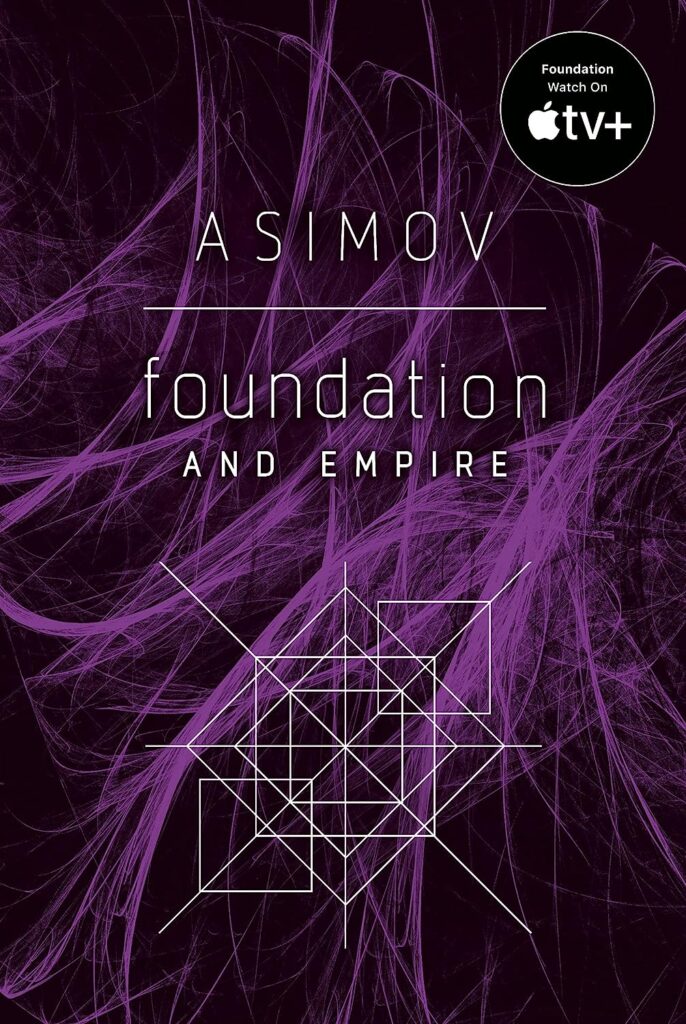Up next in my re-read of Isaac Asimov’s original Foundation trilogy is Foundation and Empire. First published in book form in 1952, the novel consists of two novellas originally published in Astounding magazine in 1945, when Asimov was 25 years old. I mention his age since it seems to me that in these stories of the 1940s, he is very much learning to develop his skills as a writer. And he learned quickly. The two novellas of Foundation and Empire, especially The Mule, show a lot more skill than the original story in the series, “The Encyclopedists.”
What keeps the Foundation series fresh and compelling in many ways is Asimov’s willingness to test his ideas in increasingly complex scenarios, including one where the predictions of psychohistory seem to fail in the face of an individual’s efforts. That’s not supposed to happen according Hari Seldon’s theory, in which broad historical factors, like the rising bureaucracy, the freezing of caste, the loss of initiative, take precedence over anything a single person could do to try to change the course of empire. But in this second volume that central idea seems to stumble over the character known as the Mule.
Foundation and Empire begins with The General, about the efforts of Bel Riose, a fleet commander for the Empire and governor of Siwenna, to seek out and destroy the threat to Imperial rule posed by the Foundation. About 50 years after the events of Hober Mallow’s victories in “The Merchant Princes” section of the first novel (or 200 years into the Foundation era), the Foundation is not much more than a rumor to Bel Riose, with his focus on the still prosperous and mighty core of the Empire. He interviews Ducem Barr, descendant of a once powerful family on Siwenna with links to Hober Mallow, in order to learn more about this mythic threat.
Barr explains the power of Foundation, attributable to the forces of psychohistory as explained by Hari Seldon. Riose scoffs at the idea that his efforts and those of the Empire are just tools of a pre-determined fate and resolves to learn more about Foundation. He goes on a scouting expedition and lets his ship be captured by Traders. Interestingly, we learn about this through a conversation among a group of Traders who have figured out that Riose allowed himself to be taken and that he poses the unprecedented threat of a potential direct attack on Terminus by forces of the Empire. In the next scene, again between Barr and Riose, we hear about the General’s skepticism about Foundation power, though he admits the ordinary residents of the Foundation seem to have a mystical belief in their destiny one day to rule the galaxy.
He prepares to conquer the planet and sends a request to the Emperor for reinforcements. He captures Lathan Devers, an Independent Trader, but Devers escapes with Barr and the two go to Trantor in an effort to turn the Emperor against the ambitious general. Their plot fails completely, but as they escape Trantor they learn, from a good old-fashioned newspaper, that Riose has been recalled and accused of treason.
It was jarring for me that the critical action took place off-page, and the key event that saved the Foundation from its latest crisis is only captured in a newspaper headline. But the last chapter brings out the major interest of Asimov: the psychohistorical explanation as to why Riose’ abortive campaign was doomed to failure. Ducem Barr explains to a group of Traders how Riose’s failed attempt to conquer the Foundation had more to do with psychohistory than with their small efforts to manipulate the situation with bribes and lies. It’s all about the political dynamics of strong emperors not tolerating anyone who develops potentially threatening power, like a strong general. This is not a matter of individuals altering history but rather an affirmation of the self-destructive course of imperial power, as predicted in Seldon’s theory.
If The General is an example of the unimportance of individuals trying to alter history, The Mule takes the opposite approach and poses the greatest threat yet to the course of psychohistory through the efforts of one man. For me, it’s the best story in the series thus far. It takes place 100 years after the events of The General, and by this time the center of the Empire at Trantor has collapsed and been mostly destroyed. A frail Emperor remains, but the real power is in the hands of a Crown Prince. The vast population of Trantor has been reduced to a few million who survive as farmers by prying off the metal structures that covered the planet to get back to the soil.
The Foundation is now a dominant power, but it too is succumbing to many of the forces that undermined the Empire. The mayoralty has become hereditary, and the current mayor, Indibur, is a weak bureaucrat who relies on strict procedure and tolerates no deviance from his orders.
The story opens as the newly married Bayta, a descendent of a great Foundation family, arrives at Haven, the home planet of her husband Toran who is part of a Trader family. Relations between Foundation and Traders have worsened over time, and a group of Traders, known as renegades, now live in Haven. This is planet orbits a red dwarf star where cities supporting the relatively small population are built inside caves. Bayta is the real star of this story, a fairly well realized female character who is considerably smarter and more observant than her young husband and who often carries the burden of explaining what’s going on to her less aware companions.
Bayta learns from Toran’s father and uncle about the takeover of the planet Kalgan by the mysterious character called the Mule. Apparently, the military of the planet gave up without a fight, and the Mule, it’s thought, is planning to conquer other planets, including Foundation. Bayta and Toran visit Kalgan, known as a pleasure retreat, to see what they can learn about its new ruler. While sunning themselves on a beach, they happen to encounter a strange, gangly creature who claims to be the court jester of the Mule himself. His name is Magnifico, and he speaks in rather contorted, vaguely literary language. Toran protects him from arrest, since he is a fugitive, and he and Bayta take him to their ship. They get back to Foundation to find the Mule’s forces closing in. They contact Ebling Mis, an elder scholar, who tries to warn Mayor Indibur of the danger posed by the Mule but is shunted aside. A strange fatalism seems to grip the population, just as a new Hari Seldon hologram is about to be played. All expect Seldon to give them the answer on how to defeat the Mule, but his analysis is wrong, focused not on an external threat but on a civil war between Traders and Foundation. Just then, the Mule’s ships threaten to attack and Indibur collapses, shouting “Surrender!”
So the Foundation has fallen, apparently at the hands of an individual, in contradiction of the Seldon Plan. Bayta, Toran, Magnifico and Ebling Mis escape the planet to try to locate the Second Foundation, now the only hope of stopping the Mule. It is there on New Trantor, as the reviving remnant of the old capitol is called, that Bayta works out the mystery, not only of the Mule’s identity but also the secret of his ability to conquer planets without a fight. It lies in his psychic powers to manipulate emotions of whole populations. She confronts the Mule with the challenge that all his conquests have only added to the barbarism of the Galaxy. She taunts him that it is the Second Foundation that he must beat, yet no one knows its location. That sets up the competing searches for the Second Foundation that comprise the action of the third novel of the trilogy.
Those last chapters of The Mule are powerful and contain some stunning revelations. They not only give Bayta the central role in seeing through the Mule’s special powers of mind but are also just shocking in their impact. Throughout Foundation and Empire, Asimov’s characters come to life more fully than in the earlier stories, and the drama is more closely integrated with the conversations that reveal what is going on. There are also powerful passages of unexpectedly lyrical prose, especially when Asimov describes the impact of a musical instrument called the Visi-Sonor. When played brilliantly by Magnifico, the sounds stimulate both the ear and the visual nerves of the brain. Here is a sample of the instrument’s impact on Bayta as she listens in darkness to his playing. She sees figures:
“that danced and flickered in their myriads; that dropped out of sight and returned from nowhere; that whipped about one another and coalesced then into a new color. … for an instant she was the center of a brilliant snowstorm, while cold light slipped off her shoulders and down her arms in a luminous ski-slide, shooting off her stiff fingers and meeting slowly in a shining midair focus. Beneath it all, the sound of a hundred instruments flowed in liquid streams until she could not tell it from the light.”
Foundation and Empire, Kindle edition, Locations 2295-2302
Foundation and Empire probes deeply into the ideas of psychohistory, through vivid characters who challenge its premises. Of its two parts, The Mule is an outstanding story that provides a powerful connection to The Second Foundation.





Leave a Reply